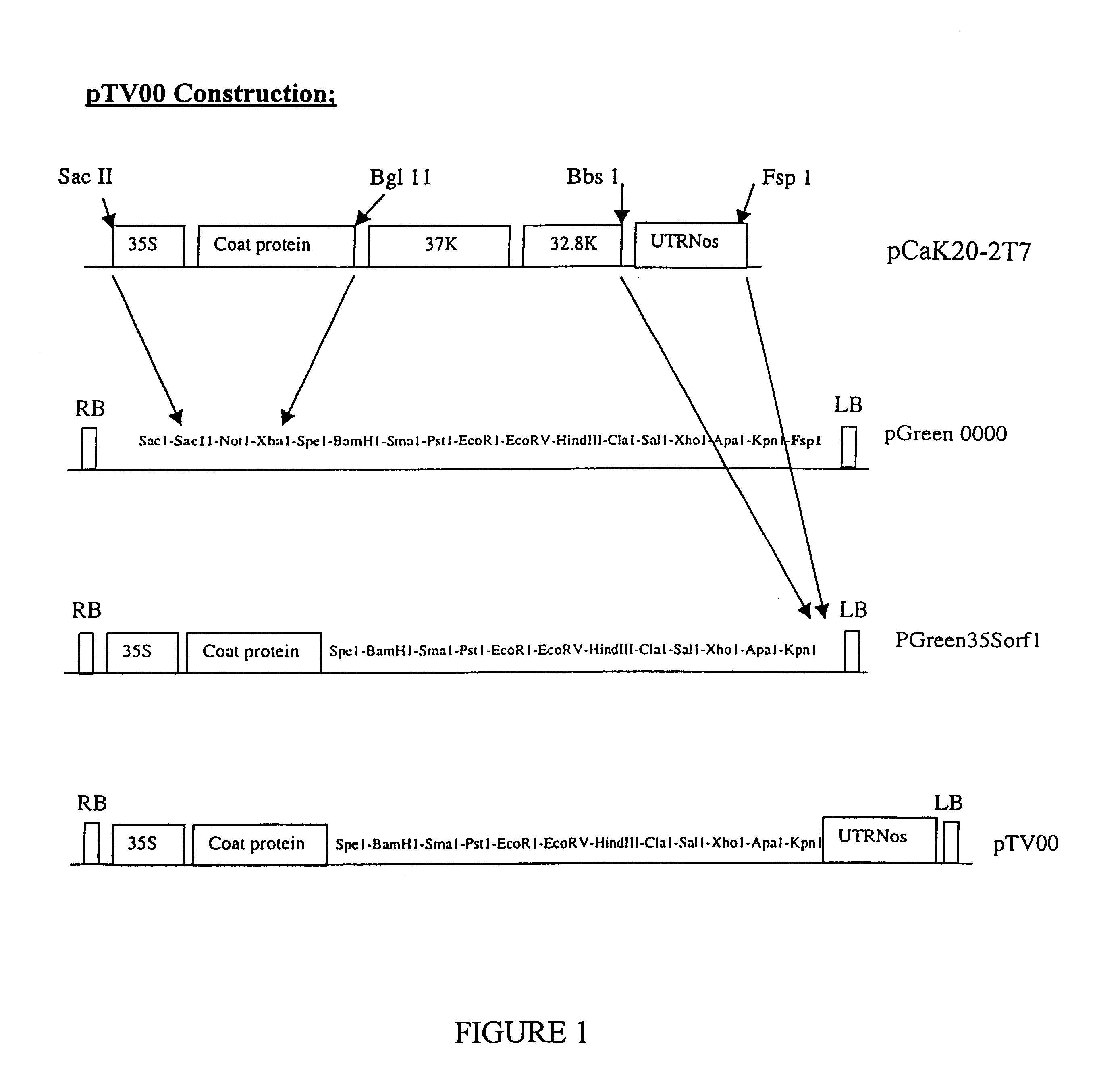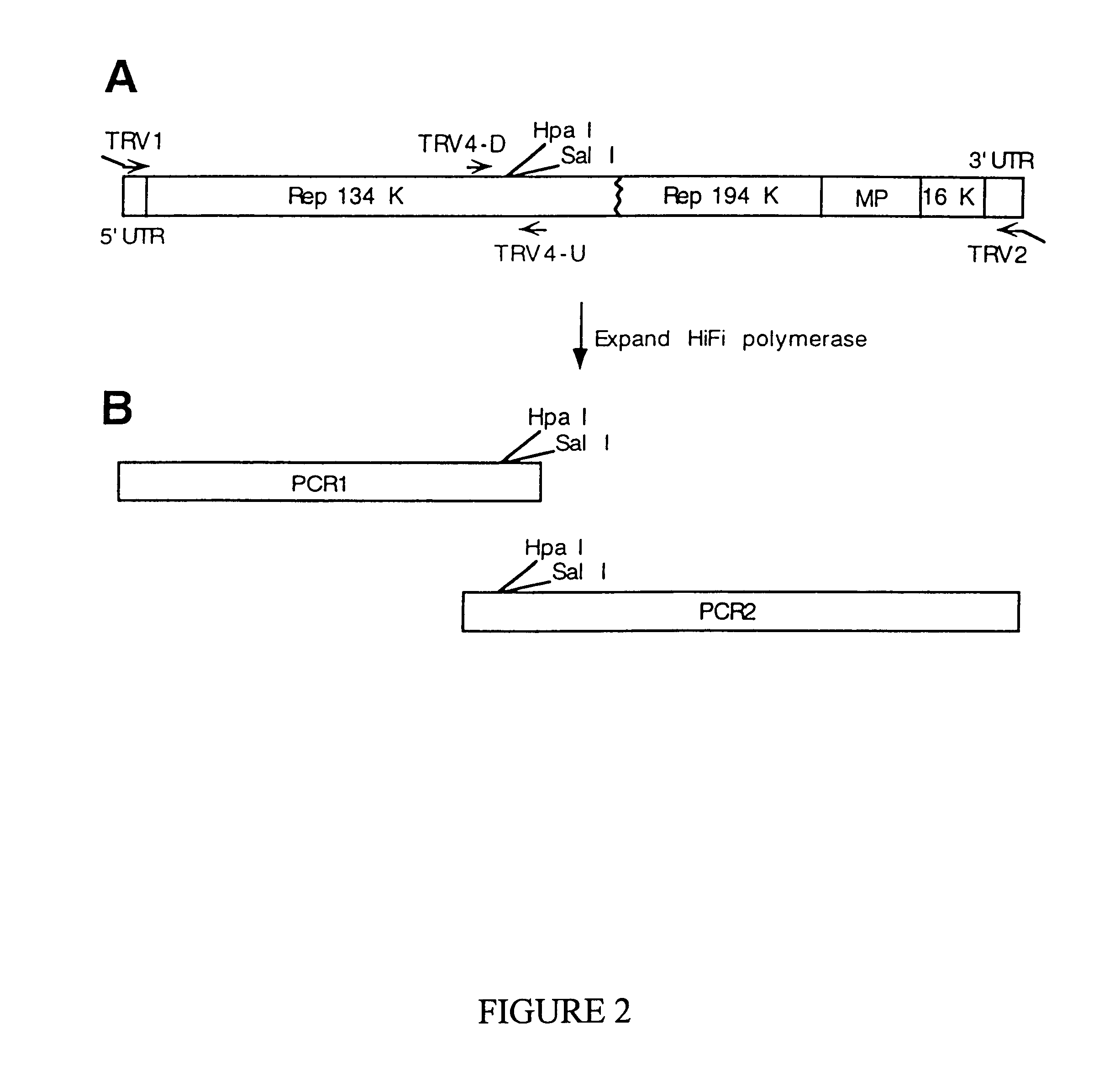Recombinant plant viral vectors
- Summary
- Abstract
- Description
- Claims
- Application Information
AI Technical Summary
Benefits of technology
Problems solved by technology
Method used
Image
Examples
example 1
Comparison of Silencing of Pds Gene by TRV and PVX VIGS Vectors
To assess whether constructs derived from TRV have advantages over previously described virus vectors, we compared symptoms and VIGS caused by TRV and another virus. PVX was used for this comparison, because it inhibits expression of a wide range of plant genes (Ruiz, Voinnet et al. 1998; Jones, Hamilton et al. 1999). Furthermore, as with TRV, an infectious PVX cDNA construct is available under control of the CaMV 35s promoter on the binary transformation plasmid "pGreen" (pGR107, (Jones, Hamilton et al. 1999)). As both TRV and PVX derivatives are therefore introduced to plants in the same way, any differences can be attributed to the virus itself, rather than the means of inoculation.
We next compared the ability of TRV and PVX derived constructs to inhibit plant gene expression in N. benthamiana. Identical plant cDNA sequences were inserted into pTV00 and pGR107 to compare the efficiency of TRV and PVX at silencing the ...
example 2
Comparison of Silencing of Rubisco by TRV and PVX VIGS Vectors
A second comparison of VIGS caused by TRV and PVX was made using the small sub-unit of ribulose -1,5-bisphosphate carobxylase oxygenase (rubisco). Antisense or PVX.rubisco induced inhibition of rubisco causes chlorotic and stunting symptoms (Rodermel, Abbott et al. 1988; Jones, Hamilton et al. 1999). A further rationale for choosing rubisco as a target of VIGS is that the copy number and expression level of the rubisco genes is very high. In contrast to pds, VIGS of rubisco would therefore indicate the potential of a virus to inhibit the expression of a high abundance endogenous mRNA. A 500 bp cDNA fragment of the rubisco small sub-unit (Appendix 4) was PCR amplified from N. benthamiana cDNA and cloned in the sense orientation into pTV00 and pGR107 to form pTV.rubisco and pGR107. rubisco respectively.
Leaves of 3 week old N. benthamiana plants were infiltrated either with Agrobacterium containing pGR107.rubisco, to cause a...
example 3
Comparison of Silencing in A. thaliana by TRV and PVX VIGS Vectors
One disadvantage of currently available virus vectors is that they have a limited host range. For example, neither PVX nor TMV vectors infect the model plant A. thaliana. In an attempt to overcome this limited host range, some authors have made transgenic A. thaliana plants that express a full-length infectious PVX cDNA carrying endogenous plant gene sequence. This strategy was pursued because PVX replicates in A. thaliana protoplasts, but does not infect whole plants. However, even when PVX is expressed from a transgene and replicating in every cell, there was little or no inhibition of homologous Arabidopsis gene expression (unpublished data).
We tested whether constructs based on TRV would inhibit gene expression in A. thaliana. A fragment of the pds gene was PCR amplified from A. thaliana cDNA (Appendix 5) and cloned the sense orientation into pTV00 to form pTV.apds. No TRV infections could be established by infilt...
PUM
| Property | Measurement | Unit |
|---|---|---|
| Temperature | aaaaa | aaaaa |
| Temperature | aaaaa | aaaaa |
| Electrical conductance | aaaaa | aaaaa |
Abstract
Description
Claims
Application Information
 Login to View More
Login to View More - R&D
- Intellectual Property
- Life Sciences
- Materials
- Tech Scout
- Unparalleled Data Quality
- Higher Quality Content
- 60% Fewer Hallucinations
Browse by: Latest US Patents, China's latest patents, Technical Efficacy Thesaurus, Application Domain, Technology Topic, Popular Technical Reports.
© 2025 PatSnap. All rights reserved.Legal|Privacy policy|Modern Slavery Act Transparency Statement|Sitemap|About US| Contact US: help@patsnap.com



